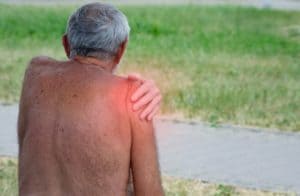Ankylosing Spondylitis is an autoimmune disease, which causes inflammation and arthritic reactions to the spine and large joints. It involves the hardening of the ligaments and tendons where they are attached to the bone. The disease affects young adults most commonly, ages 18-30. Individuals who overstretch the ligaments of the lower back and the pelvis can slowly start to experience low back problems in their early 20s and 30s. If the overstretched ligaments are not treated by tightening them the symptoms can last indefinitely.
 As in all autoimmune disorders, the immune system is fighting against the body’s tissues by creating antibodies. In ankylosing spondylitis the antibodies attack the connective tissues, resulting in stiffening of the spine due to swelling of the joints between the vertebrae. In extreme cases, the vertebrae may grow and/or fuse together.
As in all autoimmune disorders, the immune system is fighting against the body’s tissues by creating antibodies. In ankylosing spondylitis the antibodies attack the connective tissues, resulting in stiffening of the spine due to swelling of the joints between the vertebrae. In extreme cases, the vertebrae may grow and/or fuse together.
Diagnosing Ankylosing Spondylitis
The inflammation in ankylosing spondylitis typically starts around the sacroiliac joints, areas where the lower spine is fused to the pelvis. The pain associated with ankylosing spondylitis is worse when a person rests or is inactive. Pain is very common during the middle of the night. Symptoms lessen with movement and exercise. Other symptoms may include swollen, red, and painful eyes, difficulty taking a deep breath, and fatigue.
Treatments for Ankylosing Spondylitis
We offer a range of treatments to address Ankylosing Spondylitis. Our experienced team of medical professionals will work closely with you to develop a personalized treatment plan that meets your specific needs. You can trust that our qualified practitioners will utilize evidence-based practices to ensure optimal outcomes for your condition.
References on Ankylosing Spondylitis
23143785, MEDLINE, 20130802, 20220317, 1550-7416 (Electronic), 1550-7416 (Linking), 15, 1, 2013 Jan, Therapeutic roles of curcumin: lessons learned from clinical trials., 195-218, ID – 10.1208/s12248-012-9432-8 [doi], Extensive research over the past half century has shown that curcumin (diferuloylmethane), a component of the golden spice turmeric (Curcuma longa), can modulate multiple cell signaling pathways. Extensive clinical trials over the past quarter century have addressed the pharmacokinetics, safety, and efficacy of this nutraceutical against numerous diseases in humans. Some promising effects have been observed in patients with various pro-inflammatory diseases including cancer, cardiovascular disease, arthritis, uveitis, ulcerative proctitis, Crohn’s disease, ulcerative colitis, irritable bowel disease, tropical pancreatitis, peptic ulcer, gastric ulcer, idiopathic orbital inflammatory pseudotumor, oral lichen planus, gastric inflammation, vitiligo, psoriasis, acute coronary syndrome, atherosclerosis, diabetes, diabetic nephropathy, diabetic microangiopathy, lupus nephritis, renal conditions, acquired immunodeficiency syndrome, β-thalassemia, biliary dyskinesia, Dejerine-Sottas disease, cholecystitis, and chronic bacterial prostatitis. Curcumin has also shown protection against hepatic conditions, chronic arsenic exposure, and alcohol intoxication.
PubMed-not-MEDLINE, 20201001, 1792-0981 (Print), 1792-1015 (Electronic), 1792-0981 (Linking), 9 2015 Jan, T lymphocyte subset imbalances in patients contribute to ankylosing spondylitis., 250-256, AB – Ankylosing spondylitis is a chronic inflammatory rheumatic disease, which is characterized by inflammation of the spine and the sacroiliac joints. To date, the disease etiology remains unclear. In the present study, the correlation of T lymphocyte subset changes with the progression of ankylosing spondylitis was investigated. A total of 55 patients with ankylosing spondylitis (22 severe and 23 mild cases) and 20 healthy individuals were selected. Firstly, the punctured cells in the lesions and the serum were collected, and the lymphocytes and the peripheral blood mononuclear cells were prepared. Secondly, quantitative PCR, ELISA and flow cytometry analyses were carried out to detect the levels of a series of immunoglobulins, complements, helper T cells, cytotoxic T cells, regulatory cells, and cytokines. The expression levels of α-globulin, γ-globulin, immunoglobulin (Ig)G, IgA, IgM, serum complement C3, and complement C4 were found to be significantly increased in ankylosing spondylitis patients. In addition, the percentage of Th1 and Th17 cells was found to be significantly higher in the ankylosing spondylitis groups (mild and severe) compared with the healthy individuals. As a result, the Th1/Th2 and Th17/Treg ratios were significantly higher in patients with ankylosing spondylitis. In addition, T lymphocyte subset ratio imbalances contributed to an increased expression of immune mediators, including interferon (IFN)-γ and interleukin (IL)-17A. The mRNA and protein expression levels of IFN-γ and IL-17A were found to be higher in the ankylosing spondylitis groups compared with the control group. The present study provided further evidence on the function and underlying mechanism of T lymphocyte subsets, which may be useful in the diagnosis and treatment of ankylosing spondylitis. Wang, Chenggong, Wang C, Department of Orthopedics, Xiangya Hospital, Central South University, Changsha, Hunan 410008, P.R. China. Liao, Qiande, Liao Q, Department of Orthopedics, Xiangya Hospital, Central South University, Changsha, Hunan 410008, P.R. China. Hu, Yihe, Department of Orthopedics, Xiangya Hospital, Central South University, Changsha, Hunan 410008, P.R. China. Zhong, DA, Department of Orthopedics, Xiangya Hospital, Central South University, Changsha, Hunan 410008, P.R. China. Journal Article 20141104, Exp Ther Med, Experimental and therapeutic medicine, 101531947, PMC4247318, NOTNLM, 2014/12/03 Exp Ther Med. 2015 Jan;9(1):250-256. doi: 10.3892/etm.2014.2046. Epub 2014 Nov 4. https://pubmed.ncbi.nlm.nih.gov/25452811/
For answers or to make an appointment, call us toll-free at
800-923-7878 t
to speak with a Patient Care Team.
Recover your vitality, reclaim your energy and rediscover your health.


